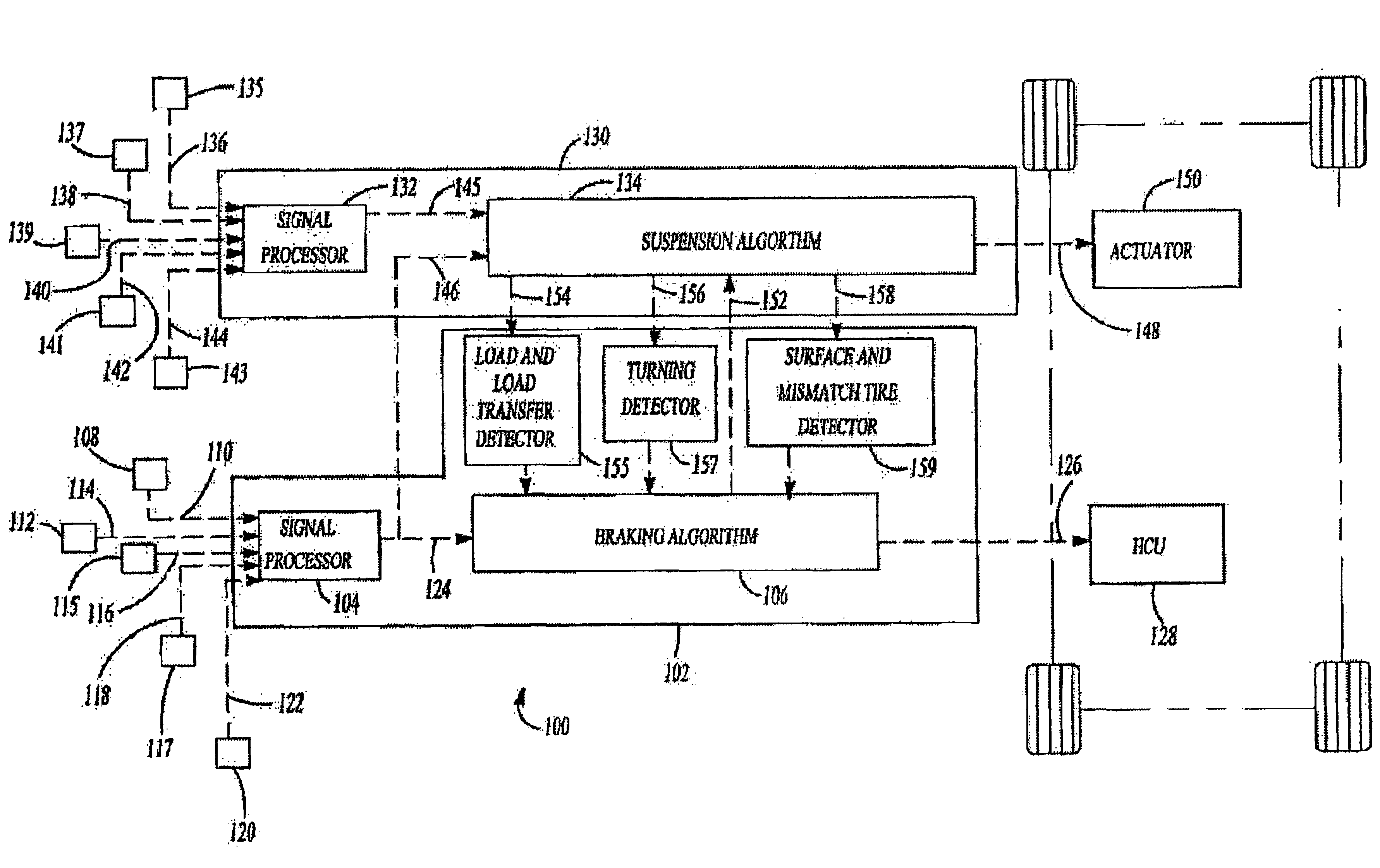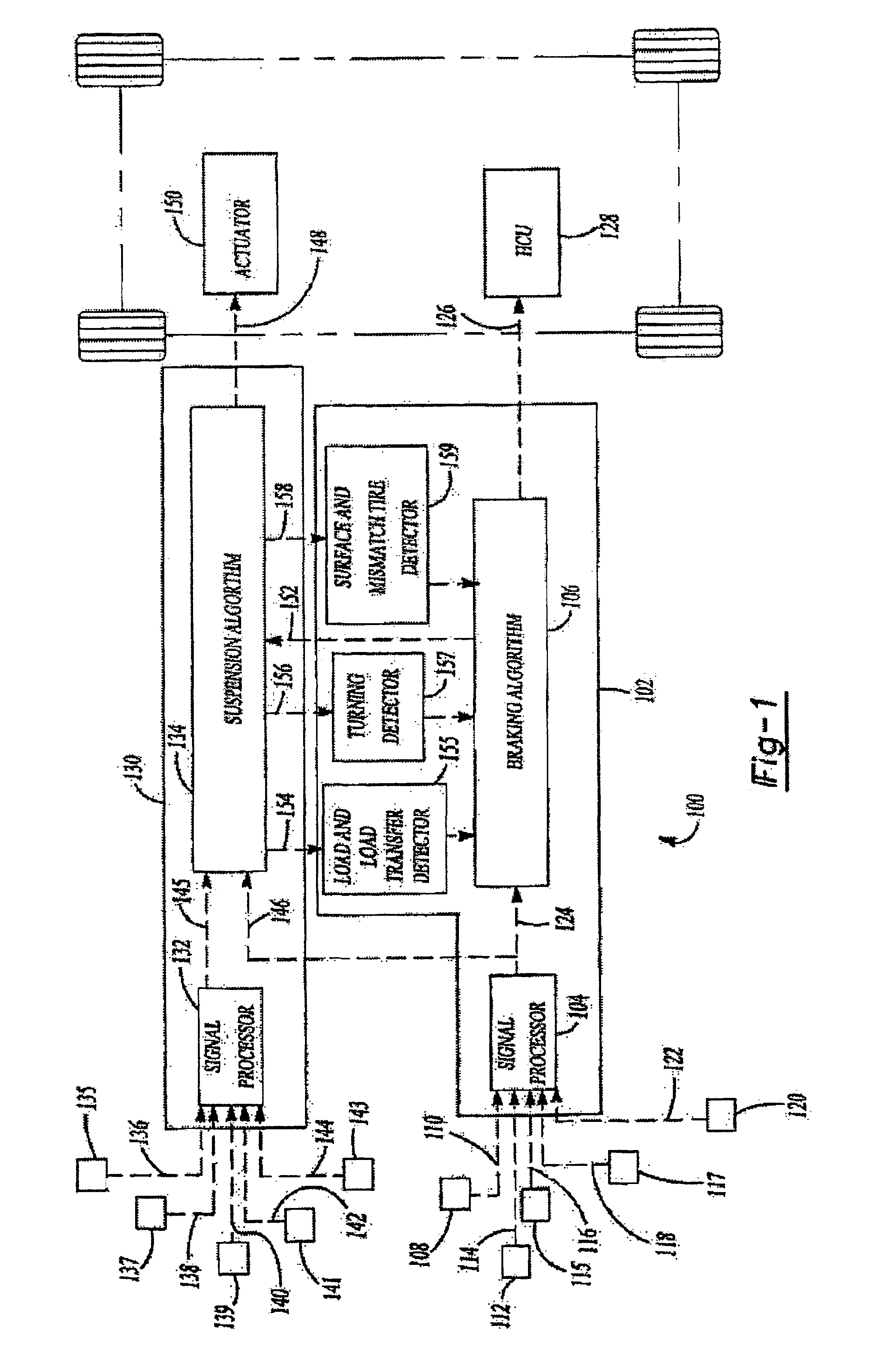Rough road detection using suspension system information
a technology of suspension system and information, applied in the direction of process and machine control, cycle equipment, instruments, etc., can solve the problem of not leading to accurate road surface classification, and achieve the effect of improving the performance of slip control
- Summary
- Abstract
- Description
- Claims
- Application Information
AI Technical Summary
Benefits of technology
Problems solved by technology
Method used
Image
Examples
first embodiment
[0019]a vehicular control system according to the present invention is indicated generally at 100 in FIG. 1. The control system 100 is particularly adapted to control fluid pressure in an electronically-controlled vehicular braking system and an electronically-controlled vehicular suspension system. The braking system can include anti-lock braking, traction control, and yaw stability control functions. The suspension system can include active damping functions.
[0020]The control system 100 includes a first electronic control unit (ECU) 102. The first ECU 102 includes a signal processor 104 and a braking algorithm 106. Various sensors 108 strategically placed in a vehicle deliver input signals 110 to the signal processor 104. Specifically, a lateral acceleration sensor 112 delivers an input signal 114 to the signal processor 104. A longitudinal acceleration sensor 115 delivers an input signal 116 to the signal processor 104. A steering wheel sensor 117 delivers an input signal 118 to ...
second embodiment
[0028]a control system for controlling vehicular braking and suspension functions is indicated generally at 200 in FIG. 2. Elements of control system 200 that are similar to elements of control system 100 are labeled with like reference numerals in the 200 series.
[0029]Control system 200 also includes an ABS / TC algorithm 206A and a YSC algorithm 206B in place of the braking algorithm 106 of control system 100. Signal processors 204 and 232 may be placed separately from their respective algorithms 206A, 206B, and 230, or they may be located in common ECU's (not illustrated in FIG. 2). Transfer signal 270 between ABS / TC algorithm 206A and VSC algorithm 206B is provided. Transfer signal 272 for load and load transfer is provided to the VSC algorithm 206B. Transfer signal 273 from the signal processor 204 is provided to the VSC algorithm 206B. Transfer signal 274 for the surface and mismatch tire detector is provided to the YSC algorithm 206B. Transfer signal 275 is provided from the YS...
third embodiment
[0039]a control system for controlling vehicular braking and suspension functions is indicated generally at 300 in FIG. 3. In control system 300, a single ECU 302 receives inputs signals 304 from various sensors 306 strategically placed in a vehicle. A signal processor 308 may be incorporated in the ECU 302 that delivers transfer signals 310 to an algorithm 312. The algorithm 312 delivers output signals 314 to a HCU 328 to provide a desired brake response. The algorithm 312 also delivers output signals 316 to actuators 350 to provide a desired suspension response. Control system 300 may be referred to as a totally integrated system for controlling vehicular braking and suspension.
[0040]The present invention employs a rough road index as a classification of the road surface for the purpose of enhancing ABS, TC and YSC functions. The generation of the rough road index will be described with reference to FIG. 4. The intent of the rough road identification algorithm is to create a signa...
PUM
 Login to View More
Login to View More Abstract
Description
Claims
Application Information
 Login to View More
Login to View More - R&D
- Intellectual Property
- Life Sciences
- Materials
- Tech Scout
- Unparalleled Data Quality
- Higher Quality Content
- 60% Fewer Hallucinations
Browse by: Latest US Patents, China's latest patents, Technical Efficacy Thesaurus, Application Domain, Technology Topic, Popular Technical Reports.
© 2025 PatSnap. All rights reserved.Legal|Privacy policy|Modern Slavery Act Transparency Statement|Sitemap|About US| Contact US: help@patsnap.com



